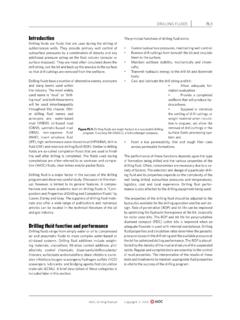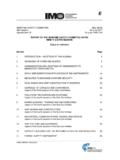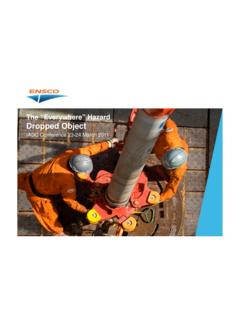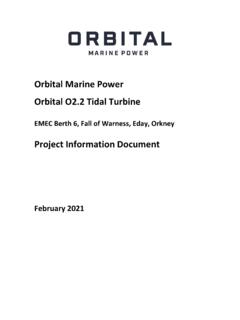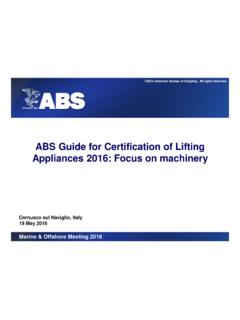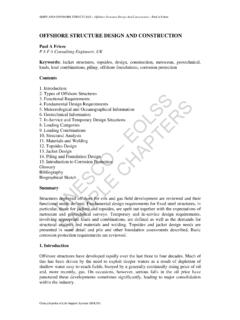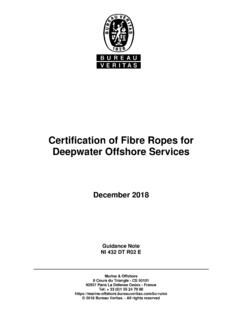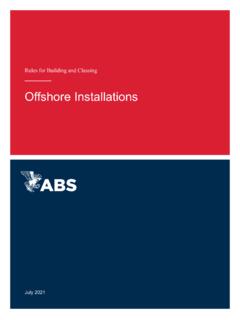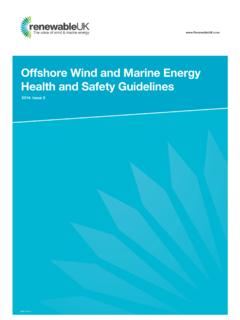Transcription of Guidelines for the Selection and Operation of Jack-ups in ...
1 Guidelines for the Selection and Operation of Jack-ups in the Marine Renewable Energy Industry Issue 2: guidance aimed at jack-up owners operators, developers and contractors engaged in site-investigation, construction , Operation and maintenance of offshore wind and marine energy acknowledges the time, effort, experience and expertise of all those who have contributed to this document. This Issue 2 of these Guidelines was prepared for RenewableUK by London offshore Consultants. This was in consultation with key consultees listed at the end of this document, RenewableUK members and key industry of this DocumentRenewableUK Health and Safety Guidelines are intended to provide information on particular technical, legal or policy issues relevant to the core membership base of RenewableUK.
2 Their objective is to provide industry-specific guidance, for example where current information could be considered absent or incomplete. Health and Safety Guidelines are likely to be subject to review and updating, and so the latest version of the Guidelines must be referred to. Attention is also drawn to the disclaimer contents of these Guidelines are intended for information and general guidance only, and do not constitute advice, are not exhaustive and do not indicate any specific course of action.
3 Detailed professional advice should be obtained before taking or refraining from action in relation to any of the contents of this guide, or the relevance or applicability of the information herein. RenewableUK is not responsible for the content of external websites included in these Guidelines and, where applicable, the inclusion of a link to an external website should not be understood to be an endorsement of that website or the site s owners (or its products/services). The lists of links and references are also not Control LogIssue 1: 2009 Original documentIssue 2: 2013 Full technical and regulatory updatePrefaceThe publication of Version 2 of these Guidelines recognises not only the growth of the offshore wind and marine sector, but also the importance RenewableUK, its members and stakeholder partners give to Health and Safety original Guidelines were published in 2009 and appear to have been well received by all key participants in the sector.
4 While the overall scope and content remain relevant, it is important that the Guidelines are kept up to date to take account of changes in legislation and standards, as well as developing experiences within the sector. In particular the revisions have aimed to take account of: Progress and experience gained through the consenting and early development phases of Round 3 projects; Experience and knowledge gained through using and referencing the original Guidelines , especially in light of the significant increase in installed offshore wind capacity; Increasing experience with wave and tidal projects and how to take into account the specific risks that may be encountered when selecting and using jack-up barges.
5 New industry guidance that has been issued, including guidance on offshore Wind and Marine Health and Safety and Vessel Safety; Lessons learned based on incidents and near misses experienced by developers and vessel operators; Changes to applicable regulatory requirements, including for example The Health and Safety at Work etc. Act 1974 (Application outside Great Britain) Order 2013; Relevant standards ( ISO) that have been amended or have replaced previous versions, with particular reference to replacement of SNAME TR5-5A by ISO 19905-1: 2012; and How marine technology and the operational use of Jack-ups has developed rapidly in recent years ( use of Dynamically Positioning (DP) capability on Jack-ups ).
6 Version 2 2013: List Of Principal Revisions To Version 1 Throughout this document the publication referred to in Version 1 describing the procedure to be followed for carrying out site-specific assessments for Jack-ups , SNAME TR5-5A, including the recommended practice, has been replaced by ISO 19905-1: 2012. Current site-specific assessments for Jack-ups that have been carried out in accordance with SNAME TR5-5A will continue to be deemed satisfactory; however, jack-up operators are encouraged to carry out future assessments in accordance with the latest international IntroductionEmphasis has been added to confirm that these Guidelines apply to Jack-ups of all types and sizes, whether self-propelled or non-propelled, manned or Legislation and guidelinesReference to the CDM regulations and to the recent extension of the HSWA to construction and maintenance activities within the Renewable Energy Zone outside Great Britain has been added.
7 The requirement to comply with site-specific rules and Guidelines issued by site owners/operators and contractors has also been Management and manningReference to the IMO Special Purpose Ships (SPS) Code has been added. The section on jack-up manning has been expanded with additional guidance on training and qualifications. A recommendation for the provision of two jacking engineers in circumstances likely to involve frequent or prolonged jacking operations has also been Planning jack-up operationsReference to the guidance under development by the Society for Underwater Technologies (SUT) has been included to emphasise the need for competently planned site investigations.
8 The requirement to plan site layouts having due consideration for the requirement to deploy Jack-ups , not only during construction , but also throughout the life cycle of the project has also been emphasised. A visual aid has been added illustrating the type of information that should be exchanged between the site operator and the jack up owner/operator in the interests of competent planning. 5. Weather-restricted and unrestricted operationsGuidance on the conduct of Weather-restricted operations has been clarified, and visual aids have been Floating condition motions and stabilityReference to Det Norske Veritas AS offshore Standard Marine Operations, General, DNV-OS-H101, or similar standards for the assessment of adequate weather windows for jack-up transit, has been Grillage.
9 Sea fastenings and cargo designMinor text revisions and corrections have been Site data required for jack-up site-specific assessmentsThe basic requirements of site investigation for jack-up site-specific assessment remain unchanged; however, the requirements for geophysical survey and soil investigation have been revised in recognition of recent advances in site investigation and assessment Jack-up foundation (soils) assessmentGuidance on jack-up foundation assessment has been revised. Advice on the assessment of punch-through risk has been added, plus a visual aid illustrating the potential consequence of scour in layered soil conditions.
10 Advice has been added to stress the importance of maintaining accurate site records of jack-up leg coordinates and leg penetrations achieved in order to improve future geotechnical assessments and to reduce the scope of subsequent analysis and/or eliminate the need to repeat time-consuming site-specific assessments for Jack-ups throughout the life cycle of the Elevated operationsThe requirement for site-specific assessment has been revised in line with ISO 19905-1, and a visual aid illustrating the assessment process has been added.

